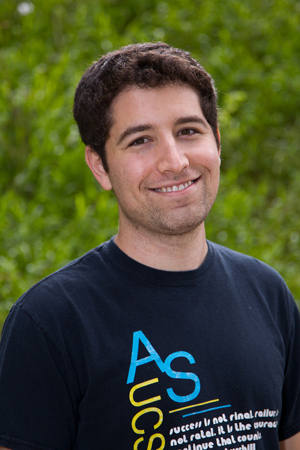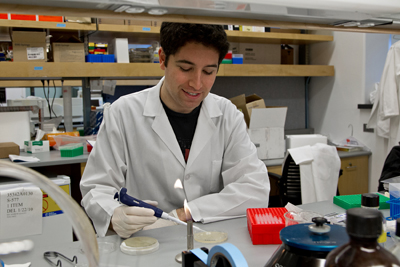Medical Student Confronts Cancer at Bench, Bedside and Beyond: Sam Brondfield

Sam Brondfield, a fourth-year medical student and leukemia researcher, is the first to be profiled in UCSF's NextGen Health, a new series about future leaders in health.
Editor's Note: NextGenHealth is a UCSF News series that highlights students, residents, and fellows who are considered future leaders in health care.
At one of the highest-ranked medical schools in the country, it’s not surprising to find students with big appetites for learning. In the laboratory, there are those who seek out challenges at the bench, peering into microscopes for answers. Others work at the bedside, guiding patients through treatment options. And then there are the caregivers who heal patients’ hearts and minds, often overlooked collateral damage when disease strikes.
Fourth-year medical student Sam Brondfield is different. He has spent his student career exploring disease in every stage. It’s ambitious, but Brondfield — who first was interested in studying the stars — has always seen the bigger picture.
Medical student Sam Brondfield talks about his work with Art for Recovery's Firefly Project, which pairs UCSF students with patients to share the experience of living with cancer.
“I started my undergrad intending to study astrophysics,” he said. “But I realized it was too far removed, literally, from my everyday life.”
Brondfield turned his sights to more earthly pursuits, earning a degree in biochemistry from Harvard. And while his parents, both doctors, had never pushed him to follow in their footsteps, his interest in medicine and helping others led him to UCSF in 2008.
“Professors were telling me that UCSF was a special place that emphasized the emotional side of caring for others,” Brondfield said. “That was appealing to me even more than its outstanding academic reputation.”
Moving Out of the Classroom and Into the Lab
At UCSF, Brondfield learned about Pathways to Discovery, an innovation training program that allows students, residents, and fellows to tackle research and other healthcare improvements in areas outside the standard curriculum. Pathways students learn how to lead in creating solutions to pressing health problems by completing additional coursework and a research project, and in some cases, additional degree programs. While most medical schools offer concentration programs, UCSF’s is unique in that it facilitates career development for students at all training levels and from all health professions.

Sam Brondfield
Through Pathways, Brondfield met Robert Nussbaum, MD, chief of the UCSF Division of Medical Genetics and director of the molecular medicine concentration, one of five pathways. Although he had never intended to do research during his clinical training, Brondfield was looking for other ways to expand his understanding of disease and treatment.
Nussbaum believes spending time in the lab can make some students better clinicians.
“The practice of medicine is and will be driven by bench research,” Nussbaum said. “It’s helpful when doctors have a deep appreciation and understanding of the process.”
It was in a cell biology course when Brondfield started to realize that his traditional medical education was being influenced by his research experience — and vice versa — particularly in the area of cancer research and treatment.
“All of a sudden there was this synergy,” he said. “Here were these two classes on different ends of the disease spectrum, but both were referencing each other constantly.”
Coming Face to Face With Cancer
Since that time, Brondfield has devoted his student career focused on cancer. He spent the time between his third and fourth year immersing himself in a cancer research lab studying MYC, a gene that is mutated in many cancers. The lab’s principal investigator, Scott Kogan, MD, UCSF professor in the Department of Laboratory Medicine, hopes the research will lead to more personalized and targeted treatment options for patients based on their own genetic makeup.
Powerful Pen-Pal Project
Members of the public are invited to attend a dramatic reading of letters exchanged between UCSF students and adults coping with life-threatening illness on Thursday, May 31. For more information, go here.
“We’re looking at very basic questions about cancer and treatment,” Kogan said. “As a physician, Sam will be better equipped to understand and recommend treatment with this additional experience.”
Brondfield doesn’t only have experience with cancer in the lab. During his third-year clinical rotations, he worked closely with cancer patients, including a woman diagnosed with Hodgkin’s Lymphoma. Not long after he helped her through her initial diagnosis, she was admitted to the intensive care unit with swelling of the brain.
“I stood over her bed while she was unconscious, breathing through a tube, and having to explain to her family what was happening,” Brondfield said. “It was a very emotional experience.”
It’s been a year since Brondfield has worked in a clinic, and he’s looking forward to seeing patients again in his final year before residency. But he hasn’t felt his time away from the hospital has been detrimental. His advisor agrees.

Sam Brondfield works in the UCSF lab of Scott Kogan, MD, a professor in the Department of Laboratory Medicine, where he conducts research that he hopes will lead to more personalized and targeted treatment options for cancer patients.
“Sam has plenty of time to do work in the clinic,” Nussbaum said. “School is the perfect time to expand his horizons.”
Helping Patients Heal After Treatment
Analyzing cancer genes and treating patients aren’t the only way Brondfield has expanded his horizons. He has taken a very personal role in the emotional recovery of patients during and after treatment. Once a month, Brondfield, an accomplished vocalist, serenades patients and their families at the UCSF Helen Diller Family Comprehensive Cancer Center at Mount Zion.
The musical entertainment is one component of Ernest H. Rosenbaum MD Art for Recovery, a program that encourages creative expression for anyone dealing with cancer through art, music and writing. Several times every week, Art for Recovery invites musicians to perform at different locations across the medical center in an effort to reduce anxiety in patients and families.
“A song, like a diary, can remind us where we were at a certain time in our life,” said Cindy Perlis, director of Art for Recovery. “For many people in a hospital waiting room, that memory is more pleasant than their present circumstances.”
If Brondfield isn’t singing to patients, he is sharing stories with them. Over the past year, he’s corresponded with a cancer patient as part of Art for Recovery’s Firefly Project. The Firefly Project is a pen pal program that matches students from UCSF medical, nursing and pharmacy schools and local high schools with adults coping with cancer and AIDS.
Sam Brondfield sings "I left My Heart in San Francisco," as part of the Art for Recovery program at UCSF Medical Center at Mount Zion.
The letter writing helps patients talk through their anxieties and offers them an opportunity to share their stories and become a mentor while the students learn what it’s like to deal with a life-threatening illness. Brondfield sees it as a natural extension of his medical education — another way to better understand what patients think about when cancer strikes.
“In the clinic, there’s this sacred relationship between doctor and patient but there’s also a wall of professionalism,” he said. “What’s great is that wall falls away because you’re also talking about your favorite musician or restaurant.”
After he earns his medical degree in June 2013, Brondfield plans to apply for an internal medicine residency and pursue an oncology fellowship. While he may not have as much time to do lab research or entertain patients with music, he doesn’t consider those experiences to be separate from his medical education.
“So much of medical school can be spent focusing on one aspect of disease when, in reality, it is a long and complicated process,” Brondfield said. These experiences at UCSF will make me a better doctor.”
Photos by Susan Merrell
Related Link: